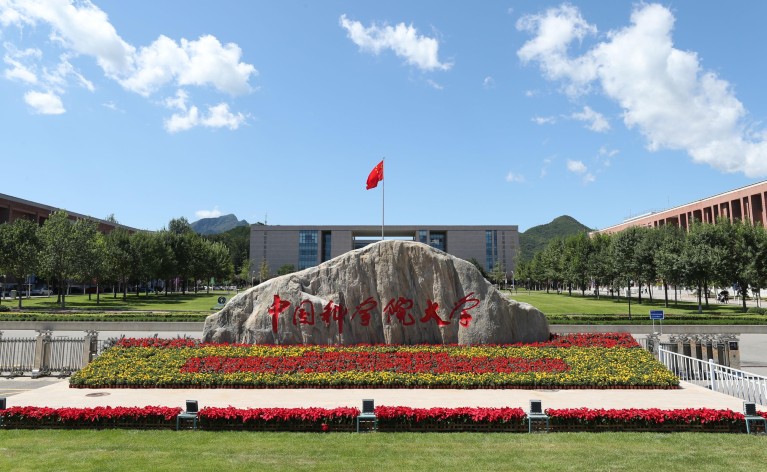
UCAS Yanqi Lake Campus.Credit: Chinese Academy of Sciences

STEP team members setting up the world’s highest automatic weather station on the top of Mount Qomolangma.Credit: Chinese Academy of Sciences
From Mount Qomolangma (or Everest) at over 8,000 metres to the Ganges Plains at 50 metres above sea level, the Tibetan Plateau captures an incredible altitudinal gradient, and its diverse ecosystem changes represent important implications for global climate change.
In May 2022, members of the Second Tibetan Plateau Scientific Expedition and Research (STEP) reached the top of Mount Qomolangma. Led by Tandong Yao, a professor of physical geography at the University of Chinese Academy of Sciences (UCAS) in Beijing, and a member of the academy, the STEP was launched in 2017 to explore how the environment around the world’s highest peak is affected by global climate change. “Over the past 40 years, I have visited the plateau more than 300 times,” Yao says, “and the more I do it, the more I like it.”
“Previously, the meteoro-logical observation stations in China were all below 5,000 metres. Earlier studies had to rely on remote sensing data and lacked support from actual data cases,” Yao explains.
Overcoming the challenges of extreme cold, hypoxia and heavy snow, the STEP team, comprising more than 7,000 researchers, 900 of whom were UCAS students, defied the odds to build eight weather stations from 5,200 metres to 8,830 metres above sea level.
For the first time, they also used high-precision radars to measure ice and snow levels at the highest peak on Earth. The cutting-edge technology can accurately measure the temperature, relative humidity, wind speed, wind direction and solar radiation of the north slope of Mount Qomolangma, signalling more effective monitoring for high-altitude glaciers and snow changes.
Problems at the top
The Tibetan Plateau is Asia’s most important source of water, and this groundbreaking work has uncovered imbalances in its systems that could potentially lead to disaster in the region. Such important findings draw attention to the importance of Chinese environmental research.
“China is leading the world in the field of glacier change research,” says Yanfen Wang, executive vice president of UCAS. She adds that the university, which has more than 3,000 full-time faculty, continues to attract top talent from all over the world.
Founded in 1978 by the Chinese Academy of Sciences, UCAS has committed to cultivating leading talent in areas of science and technology. The university awarded the nation’s first doctoral degree in science, the first doctoral degree in engineering, as well as the first doctoral degree awarded to a woman.
Putting scientific research at the forefront of its mission, UCAS advocates “the integration of scientific research and education,” Wang explains. The dean of each college is the director of the host institute, and all professors are active scientists in addition to their teaching and student advising responsibilities.
Led by these advisors, students at UCAS have opportunities to join research teams and participate in research programmes, even at the national level, such as the STEP. Many UCAS students have already published their work in top journals like Nature even during the undergraduate stage. “UCAS young students not only mean the future of Chinese scientific enterprise, but also an important part of our team for the STEP. They have already contributed a lot to the success of our programme,” says Yao.
“Our mission in the future,” Wang says, is “to become a place where top scientists and outstanding students gather, and to rank among the top universities in the world.”
This advertisement appears in Nature Index 2022 Innovation, an editorially independent supplement. Advertisers have no influence over the content of the editorial articles within this supplement.


